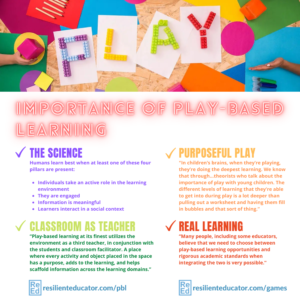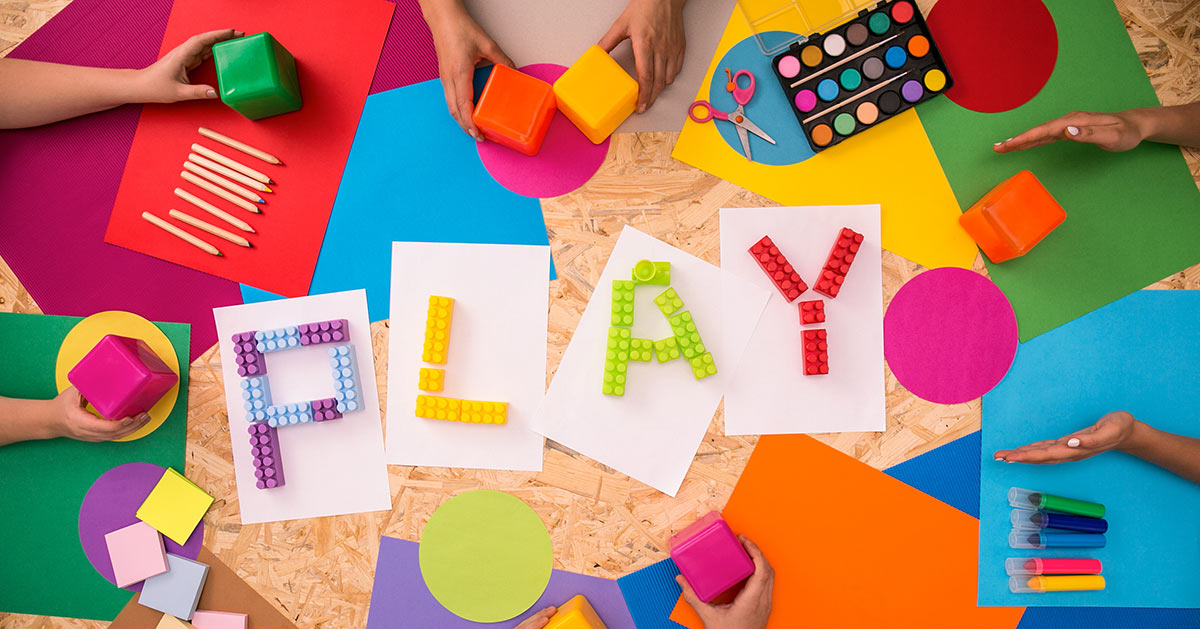
The No Child Left Behind movement seemed to discount the importance of play-based learning in favor of more explicit instruction and testing in the lower grades. But researchers and educators agree that play is a critical part of childhood learning that should not be sidelined. Here’s a look at the latest research on the importance and impact of play-based learning.

The science of play-based learning
A great deal of research has concluded that play-based learning is genuinely and positively impactful on student learning and development. Kathryn Hirsh-Pasek, a well-known child development expert in the Department of Psychology at Temple University and a Senior Fellow at the Brookings Institution, argues that humans learn best when at least one of these four pillars are present:
- Individuals take an active role in the learning environment
- They are engaged
- Information is meaningful
- Learners interact in a social context
This means that children learn well when they are mentally active, engaged, social, and can make meaningful connections to their lives, which are all characteristics of play.
Another study found that “in addition to improving play skills and narrative language ability,” a play-based curriculum also had “a positive influence on the acquisition of grammar.” Neuroscientists have found that play activates the brain in meaningful ways that rote memorization, testing, worksheets, and traditional classroom techniques do not.
“When you are engaging in play, which in and of itself is a symbolic metaphor in its truest form, whole parts of your brain are engaged, developing crucial connections that lead to a positive development of the child,” says Clair Mellenthin, author of Play Therapy: Engaging & Powerful Techniques for the Treatment of Childhood Disorders.
Beyond stimulating young minds to be receptive to learning, play is a necessary component of brain development for children. “Not only is it an incredible source of fun and socialization, but play is also crucial to children’s learning and development. Their intellectual, physical, and social-emotional abilities emerge and are strengthened through play,” says Katie Chiavarone, blogger and author of The Undeniable Power of Play: 101 Tips, Activities and Play-Based Learning Strategies to Engage Your Child. “It is in the context of play that children test out new knowledge and theories. They reenact experiences to solidify understanding. And it is where children first learn and express symbolic thought, a necessary precursor to literacy. Play is the earliest form of storytelling. And, it is how children learn how to negotiate with peers, problem-solve, and improvise.”
What the research says about play-based learning
Play-based learning is more than a failure-free way for children to practice essential skills and social interactions. It creates a fair, positive environment and can close achievement gaps that may exist for some children in all learning environments.
The LEGO Foundation published a report that surveyed over 26 studies of play from 18 countries. Research on play-based learning indicates that, in economically disadvantaged communities, young children thrive in learning environments that incorporate a mix of instruction with both guided and unstructured play.
Specifically, they showed significant learning gains in social-emotional development, motor skills, and language and literacy. This contrasted with more traditional school environments that focused primarily on academic outcomes and school readiness, providing fewer opportunities for child-led, unstructured play.
In many school districts, the focus is on academic skills and standardized assessments. Unfortunately, this approach may not just be ineffective for children from under-resourced communities — it could have a cumulative negative impact on social and academic development.
A play-based learning environment helps children from all economic and social backgrounds develop essential life skills, including resolving conflicts, sharing, and responding to the ideas of their peers.
Play-based learning is real learning
The assumption that play is a frivolous use of classroom time and in opposition to rigorous instruction demeans its value and its vast potential. “Many people, including some educators, believe that we need to choose between play-based learning opportunities and rigorous academic standards when integrating the two is very possible,” says adjunct professor, Angie Stratton, M.A.Ed. “For example, a kitchen/cooking center could contain a water table as well as measuring cups, dishes and ‘pretend’ food. Paper and pencils/crayons/markers, etc., can be used to write recipes, make lists, and create advertisements for a new restaurant. The creative possibilities are endless. Not only does this play-based learning center address language arts standards, but it also touches upon speaking and listening standards as well. Intentionally structuring a play-based learning opportunity to encourage creative play as well as include materials that emphasize a developmentally appropriate learning standard is certainly a high-leverage practice.”
Purposeful play
Play is not an obstruction to academic learning, nor is it lazy teaching. Purposeful play experiences can be constructed to create deeper learning experiences that a child will remember and internalize. “High-quality classrooms that utilize play-based, hands-on learning activities are well-thought-out, intentional spaces — not just a free-for-all where the children jump from activity to activity and a teacher is disengaged and spends his/her day managing behaviors,” says early childhood educator, Tina Gabel, MEd. “In an exceptional play-based atmosphere, there are no worksheets to showcase understanding and learning; instead, the formal documentation is gathered through learning stories, anecdotal notes, and photo assessments.”
Lauren Harness, MEd, agrees. “When people say ‘play-based learning,’ I think what they go to is: ‘Just put them in a room with a bunch of toys and let them go at it. There you go, that’s play-based learning.’ But really purposeful play should be in classrooms, especially in a kindergarten classroom. In children’s brains, when they’re playing, they’re doing the deepest learning. We know that through Piaget, Vygotsky, and all those good theorists who talk about the importance of play with young children. The different levels of learning that they’re able to get into during play is a lot deeper than pulling out a worksheet and having them fill in bubbles and that sort of thing.”
How to develop a play-based curriculum
Play-based learning is often confused with a hands-off approach to education. While unstructured playtime is an essential part of any pre-K environment, a play-based curriculum is carefully planned and implemented with the holistic development of children in mind.
In a play-based pre-K program, children can typically choose activities that appeal to their current interests. Play is used as a vehicle for teaching social studies, science, literacy, and numeracy, letting teachers convey information in a way that’s engaging and fun. To an outsider, it may look as though children are just playing.
However, a carefully planned curriculum guides children in learning educational, emotional, and social skills in a way that is natural to them.
A play-based learning environment engages students’ five senses during lessons. While it still provides a space for traditional instruction and worksheets, which can offer important feedback on students’ progress, it uses other modalities and manipulatives to help students engage with information.
Tips for play-based pedagogy
Play-based pedagogy is based on the idea that experience takes priority over content. Children may not absorb everything their teacher says during a lesson, but they’ll remember the activities and hands-on experiences weeks or even months later.
While this method differs from standard practices in many schools and learning centers, teachers can implement play-based pedagogical approaches in several ways:
- When planning activities, think specifically about the lesson the students need to learn, how to set the stage for learning, and the strategies that may help produce the desired outcome.
- When challenges arise, ask guiding questions to help the children find problem-solving solutions.
- Encourage effort and persistence throughout a project or challenge, not just when it’s completed or resolved.
- Engage during play by introducing a challenge to a game.
- Use ongoing documentation to assess children’s soft skills and cognitive development.
Creating an ideal play-based learning environment
According to Loris Malaguzzi, the Italian educator and psychologist who pioneered the Reggio Emilia approach, the classroom itself plays a crucial role in learning and acts as the third teacher after the instructor and a child’s peers. To that end, the learning space should be welcoming, visually interesting, and culturally representative of its community.
Distinct stations
Play-based learning environments typically feature distinct stations. These may include areas for reading, dramatic play, blocks, water play, and crafts. Some teachers keep these stations separate by putting visual barriers in place, whether that’s installing a low wall or simply laying masking tape on the floor to designate spaces.
Connect play materials to classroom learning
Even in classrooms where creating designated stations isn’t practical, play-based learning can still take center stage through play materials and manipulatives. Some teachers use puppets to represent characters in books they read with their students, while others use blocks to aid them in math lessons.
Matching games can be effective in teaching science concepts (such as matching animals to their habitats), and toy cars or sensory play with shaving cream can help students memorize consonant blends.
Play games
Games are an effective way to practice using new concepts and reviewing past material. Some popular games include:
- Eye spy
- Charades
- Guessing games
- Scavenger hunts
- Bingo
Maintain a careful schedule
Children are more relaxed and able to learn in an organized environment with a predictable schedule. Ideally, student- and teacher-led play should be woven throughout the day, and plenty of time should be available for both.
Take play breaks throughout the day
As many states adopt different ways to measure academic progress, recess is rarely prioritized. These breaks are becoming shorter or disappearing altogether in some schools, giving children less downtime between cognitively challenging tasks.
While many teachers may not have the flexibility to extend recess breaks, sprinkling play breaks throughout the day can help children stay engaged.
The classroom space as a teacher
When play-based learning is done well, the classroom becomes a teacher. “Play-based learning at its finest utilizes the environment as a third teacher, in conjunction with the students and classroom facilitator. A place where every activity and object placed in the space has a purpose, adds to the learning, and helps scaffold information across the learning domains,” says Gabel.
“Play-based learning in my classroom looks like a small group of students creating structures in the block area, while others are working in the art, science, and library areas. The conversation among students is about the new facade being put on the building across the street from our school. The students are recreating what they have seen outside of our immediate environment. Another student decides to join, where the children remind her ‘only 4 at a time in blocks.’ She then counts how many are already in the block center by matching students to the fingers she begins to hold up, and decides that she can join ‘because 3 and 1 are 4, right Mrs. Gabel?’ It is through these rich experiences and conversations that I am able to discern her concrete understanding of whole numbers.” That sure sounds a lot more engaging and authentic than a workbook quiz. Play on.
